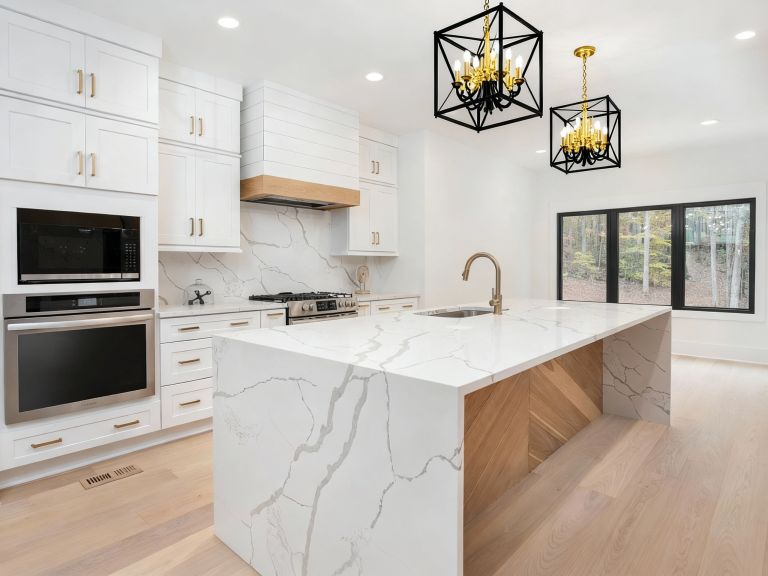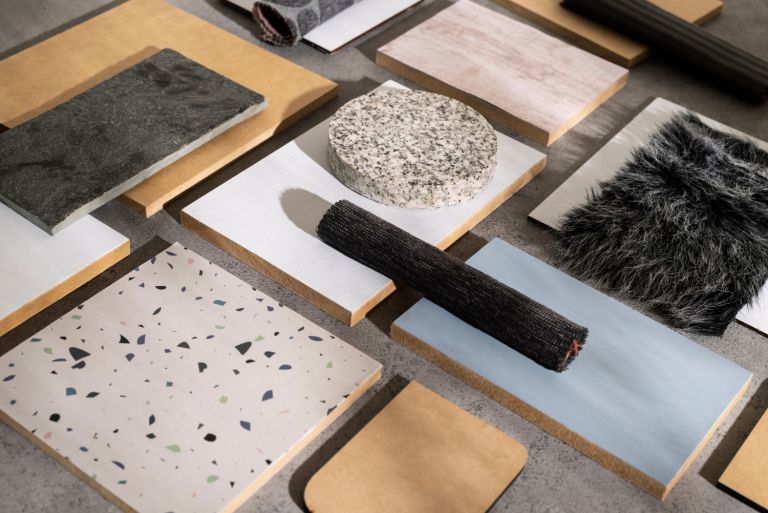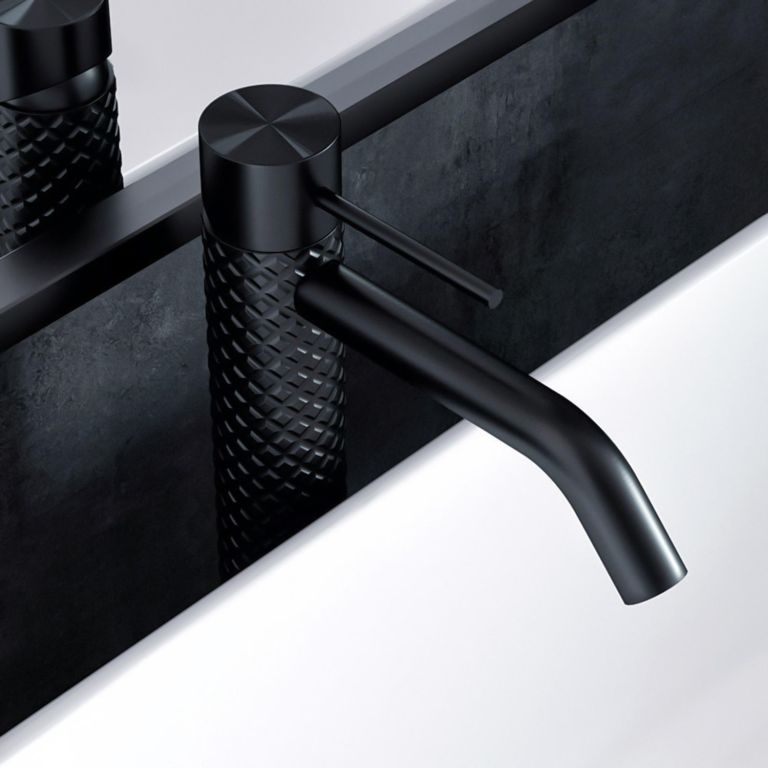Small Details, Major Impact
Cabinet hardware represents one of the highest-return design investments in kitchen renovations. For 300−300−1,500, you can completely transform your kitchen’s appearance without touching cabinets, countertops, or appliances. Yet hardware selection confuses many homeowners. Trends shift, finishes multiply, and sizing questions create decision paralysis.
At Greenberg Design Gallery, we guide clients through hardware selection daily. Our Palo Alto showroom features hundreds of options across every finish, style, and price point. This guide shares the trends dominating 2025 kitchens and provides expert advice for selecting hardware that elevates your design.
Top Hardware Finish Trends for 2025
1. Matte Black: Still Dominant
Matte black hardware continues its multi-year dominance in 2025. The finish works across design styles from modern farmhouse to contemporary minimalist.
Why It Works
- Creates strong visual contrast against light cabinets
- Sophisticated without being flashy
- Hides fingerprints better than polished finishes
- Coordinates with appliances in matching finish
- Timeless enough for long-term satisfaction
Considerations
- Shows water spots in wet areas
- Requires regular wiping to maintain appearance
- Overdone in some markets (consider alternatives for differentiation)
Best Applications: White or light-colored cabinets, modern aesthetics, farmhouse kitchens
2. Brushed Gold and Champagne Bronze: Rising Stars
Warm metallic finishes gained significant ground in 2024-2025.
Brushed Gold (Not Brass)
Modern brushed gold differs from traditional brass:
- Cooler, more refined tone
- Subtle luxury without ostentation
- Pairs beautifully with white, gray, and navy cabinets
Champagne Bronze
Sits between gold and oil-rubbed bronze:
- Warm but not yellow
- Sophisticated and timeless
- More versatile than traditional bronze
Best Applications: Transitional and traditional kitchens, light cabinets, when coordinating with gold/bronze faucets
3. Polished Nickel: Timeless Elegance
Polished nickel offers understated luxury.
Appeal
- Cool but warmer than chrome
- Develops subtle patina over time
- Classic high-end look
- Coordinates with stainless appliances
- Never goes out of style
Considerations
- Shows fingerprints readily
- Requires frequent polishing
- More expensive than brushed alternatives
- Patina may not suit everyone
Best Applications: Traditional and transitional kitchens, classic aesthetics, formal spaces
4. Mixed Metal Finishes: Curated Coordination
Mixing hardware finishes strategically creates visual interest.
Popular Combinations
- Matte black pulls + brushed gold knobs
- Brushed nickel larger pieces + champagne bronze accents
- Matte black primary + unlacquered brass feature pieces
Rules for Successful Mixing
- Choose two finishes maximum (three looks chaotic)
- Repeat each finish at least 3-4 times
- Use one finish for functional pieces, another for decorative
- Maintain same finish family (all warm or all cool tones)
- Match finish families to plumbing fixtures
Best Applications: Large kitchens with varied cabinet types, eclectic or transitional styles
5. Unlacquered Brass and Living Finishes
Living finishes that develop patina gain popularity among design-forward clients.
Character
- Changes over time with use
- Each installation unique
- Organic aging process
- Requires acceptance of imperfection
- Authentic, artisanal appearance
Best For: Farmhouse, eclectic, vintage-inspired designs
Style Trends
Minimalist and Slab Pulls
- Clean, horizontal lines
- 12″-24″ lengths common
- Creates sleek, handle-less appearance
- Works with modern, contemporary, and Scandinavian styles
- Cost: 15−15−45 each
Oversized Hardware
- Larger than traditional 3″-4″ pulls
- 5″-8″ pulls and 1.5″-2″ knobs
- Makes bold statement
- Suits farmhouse and traditional styles
- Cost: 12−12−35 each
Geometric and Angular Designs
- Hexagonal, square, and architectural shapes
- Modern and contemporary appeal
- Creates visual interest
- Coordinates with geometric tile patterns
- Cost: 18−18−50 each
Cup Pulls and Bin Pulls
- Vintage-inspired designs
- Perfect for farmhouse and traditional kitchens
- Comfortable grip
- Classic appearance
- Cost: 8−8−25 each
Backplates and Escutcheons
- Added dimension and detail
- Covers existing holes when changing hardware
- Traditional and vintage aesthetics
- Extra layer of design
- Cost: 6−6−20 each (plus pull/knob)
Sizing and Placement Guidelines
Pull Sizing
- Drawer pulls: 3″-5″ for standard drawers
- Wide drawers: 6″-12″ pulls (or two pulls)
- Cabinet doors: 3″-4″ pulls typical
- Pantry and tall cabinets: 8″-12″ pulls
Knob Sizing
- Standard: 1.25″-1.5″ diameter
- Oversized trend: 1.75″-2.25″ diameter
- Small drawers: 1″ diameter
Placement
- Upper cabinets: Mount pulls on bottom rail
- Base cabinets: Mount pulls on top rail
- Drawers: Center horizontally, 1″-2.5″ from top edge
- Consistency matters more than absolute measurements
Greenberg Design Gallery provides templates and placement guidance to ensure professional results.
Hardware by Cabinet Style
Shaker Cabinets (Most Versatile)
Compatible with nearly any hardware:
- Bar pulls for modern look
- Cup pulls for farmhouse style
- Knobs for traditional aesthetic
- Minimal pulls for contemporary design
Flat-Panel Modern Cabinets
Best with:
- Long horizontal pulls
- Minimal edge pulls
- Integrated channels (no hardware)
- Simple geometric knobs
Traditional Raised-Panel Cabinets
Complement with:
- Ornate knobs
- Backplate pulls
- Oil-rubbed bronze or brass
- Cup pulls and bin pulls
European Frameless Cabinets
Pair with:
- Sleek bar pulls
- Minimal integrated pulls
- Contemporary knobs
- Concealed push-to-open systems (no hardware)
Cost Breakdown
Budget Hardware (2−2−8 per piece)
- Basic finishes and styles
- Limited durability
- May tarnish or wear quickly
- Suitable for short-term rentals or flip properties
Mid-Range Hardware (8−8−25 per piece)
- Quality finishes that last
- Good variety of styles
- Durability for daily use
- Sweet spot for most renovations
Premium Hardware (25−25−100+ per piece)
- Exceptional finishes and craftsmanship
- Unique designs and materials
- Maximum durability
- Luxury kitchens and high-end renovations
Typical Kitchen (30 cabinets + drawers)
- Budget: 150−150−300
- Mid-range: 400−400−1,200
- Premium: 1,200−1,200−4,000+
Installation Tips
DIY Installation
Cabinet hardware installation is DIY-friendly with proper tools:
- Template for consistent placement
- Drill with appropriate bits
- Screwdriver or hex wrench
- Painters tape to prevent cabinet damage
- Level for accuracy
Professional Installation
For perfect results, professional installation costs:
- 3−3−6 per piece installed
- Includes precise measurement and placement
- Ensures alignment and consistency
- Total for 40 pieces: 120−120−240
Common Installation Mistakes
- Inconsistent placement (looks unprofessional)
- Wrong screw length (protrudes inside cabinet)
- Over-tightening (cracks door or drawer front)
- Uneven spacing on multi-pull applications
- Failure to use template (creates visible errors)
Current Greenberg Design Gallery Popular Selections
Best-Selling Finishes (2025)
- Matte black (35 percent of sales)
- Brushed gold (22 percent)
- Polished nickel (15 percent)
- Champagne bronze (12 percent)
- Brushed nickel (10 percent)
- Other finishes (6 percent)
Most Popular Styles
- Simple bar pulls (3″-5″)
- Oversized cup pulls
- Minimalist knobs
- Long slab pulls (8″-12″)
- Geometric designs
Trending Brands
Our showroom features hardware from:
- Top Knobs (wide variety, quality finishes)
- Amerock (good value, extensive selection)
- Atlas Homewares (unique designer options)
- Jeffrey Alexander (traditional and transitional)
- European imports (premium collections)
Visit Greenberg Design Gallery to see these collections in person and test how hardware feels in your hand.
Coordinating Hardware with Plumbing Fixtures
Finish Coordination Rules
Perfect Match
- Kitchen faucet and cabinet hardware in identical finish
- Creates cohesive, intentional design
- Safest coordination approach
Complementary Finishes
- Hardware and faucet in same tone family (both warm or both cool)
- Different finishes but compatible metals
- Example: Brushed gold faucet + champagne bronze hardware
Intentional Contrast
- Different finish families used deliberately
- Example: Matte black hardware + brushed nickel faucet
- Requires confidence and good design eye
- More challenging to execute successfully
Our Recommendation: Match or closely coordinate hardware and plumbing finishes in kitchens. Bathrooms allow more mixing flexibility.
Maintenance and Longevity
Finish Durability by Type
Most Durable
- Brushed stainless steel (nearly indestructible)
- Solid brass with protective coating
- Matte black powder coat
- Polished chrome
Moderate Durability
- Brushed nickel
- Brushed gold
- Oil-rubbed bronze
- Champagne bronze
Requires Care
- Polished brass (tarnishes without lacquer)
- Unlacquered living finishes (intentional patina)
- Polished nickel (shows wear patterns)
Cleaning and Care
- Wipe daily with soft cloth
- Use mild soap and water only
- Avoid abrasive cleaners
- Dry thoroughly to prevent water spots
- Never use acidic or harsh chemical cleaners
Quality hardware maintains appearance for 15-25+ years with proper care.
When to Update Hardware
Signs It’s Time
- Loose or wobbly hardware (stripped screws)
- Finish wearing off or tarnishing
- Style looks dated
- Changing cabinet color (coordinate with new color)
- Hardware doesn’t function smoothly
Before vs. After Impact
Hardware updates rank among highest ROI updates:
- Cost: 500−500−1,500 typical kitchen
- Time: 2-4 hours DIY
- Visual impact: Transforms entire kitchen
- ROI: Often 100-150 percent (especially when selling)
Sizing Transitions
Replacing Existing Hardware
Same Size
- Simplest installation
- Existing holes align perfectly
- No filling or drilling required
Different Size
- May require filling old holes
- Wood filler, sand, touch-up paint
- Drill new holes at correct spacing
- Adds time but allows style change
Single to Double Pulls
- Large drawers benefit from two pulls
- Requires drilling additional holes
- Creates more balanced, proportional appearance
Current Anti-Trends
What’s fading from Bay Area kitchens:
Losing Popularity
- Oil-rubbed bronze (overused, looking dated)
- Ornate, overly decorative hardware
- Crystal and glass knobs (except vintage/eclectic homes)
- Polished chrome (too clinical for residential)
Still Works But Plateauing
- Brushed nickel (reliable but common)
- Vintage bin pulls (peaked, still acceptable)
Future Forecast: What’s Next
Emerging for 2026
- Unlacquered brass (living finish gaining momentum)
- Mixed materials (leather wraps, wood inlays)
- Ultra-long pulls (18″-36″ for oversized cabinets)
- Invisible/integrated pulls (handle-less European style)
- Textured finishes (hammered, rippled)
Greenberg Design Gallery stays ahead of trends, introducing new products as they gain traction.
Budget Allocation Guidance
In kitchen renovation budgets, hardware typically represents:
- 1-2 percent of total budget (modest)
- Outsized visual impact for small investment
- Higher percentage in cabinet painting projects
- Lower percentage in full gut renovations
Example Budget Allocations
$50,000 Kitchen Remodel
- Hardware budget: 500−500−1,000
- Choose mid-range quality
- Splurge on 2-3 statement pieces
$100,000 Kitchen Renovation
- Hardware budget: 1,000−1,000−2,000
- Premium finishes throughout
- Custom or designer options
$25,000 Cabinet Painting Project
- Hardware budget: 800−800−1,500
- Major contributor to new look
- Higher percentage of smaller budget
Testing Before Committing
Visit Greenberg Design Gallery
Our showroom allows hands-on evaluation:
- Feel hardware weight and quality
- Test pull mechanisms
- See finishes in various lighting
- Compare sizes side-by-side
- Experience subtle finish differences
Many online photos misrepresent actual appearance. In-person evaluation prevents expensive mistakes.
Order Samples
For online purchases, order 2-3 samples before bulk ordering:
- Test with your cabinet color
- Evaluate in your lighting
- Confirm size and proportion
- Verify finish match with other elements
Sample investment: 20−20−60 prevents 500−500−1,500 in wrong purchases.
Final Thoughts
Kitchen cabinet hardware bridges function and aesthetics. The right selection enhances your design while providing years of smooth operation. The wrong choice creates daily visual discord and potential functional frustrations.
Fortunately, hardware offers affordable design impact. Even premium options represent modest investment relative to overall kitchen budgets. This makes hardware an ideal splurge category where quality and aesthetics both matter.
Current trends favor matte black’s enduring appeal, warm metals gaining ground, and mixed finishes creating custom looks. However, the best hardware choice aligns with your specific cabinets, overall design, and personal aesthetic preferences rather than blindly following trends.
At Greenberg Design Gallery, we help Bay Area homeowners discover hardware that perfects their kitchen design. Our extensive selection includes trending finishes and timeless classics across all price points. Our design team provides expert guidance on coordination, sizing, and installation.
Visit our Palo Alto showroom to explore cabinet hardware options, see trending finishes in person, and find the perfect pulls and knobs for your kitchen renovation.






